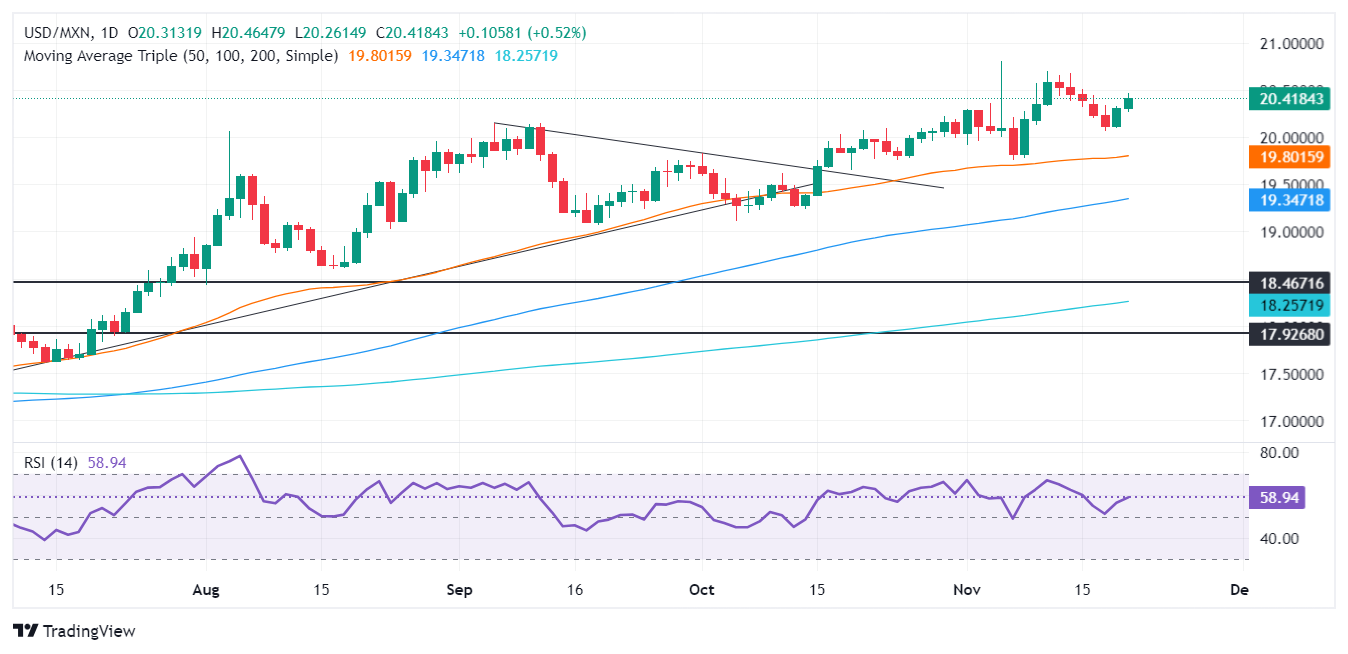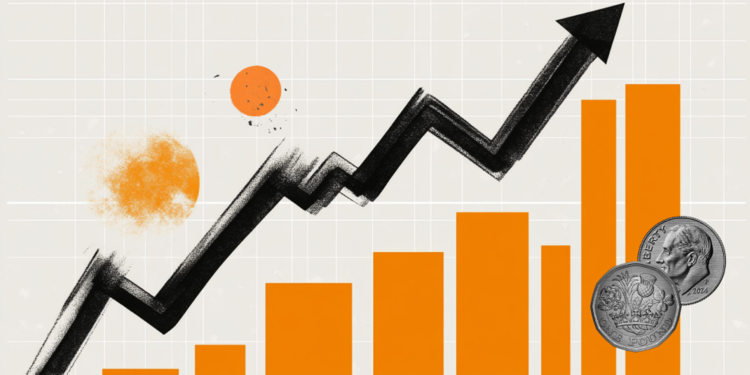- The Mexican Peso falls against the US Dollar amid continued geopolitical concerns and disappointing local data.
- The US Dollar Index hits a new yearly high of 107.06.
- Banxico’s governor signals the possibility of more rate cuts, adding pressure to the peso’s short-term outlook.
The Mexican Peso depreciated against the US Dollar on Thursday due to risk aversion as the conflict between Russia and Ukraine escalates. Additionally, a weak retail sales report in Mexico and strong employment data in the US weighed on the emerging market currency, which has fallen 1.86% for the month. At the time of writing, USD/MXN is trading at 20.39, up 0.71%.
Geopolitics continued to drive the price action. Consequently, the Dollar reached a new yearly high (YTD) against a basket of six currencies known as the US Dollar Index (DXY). The DXY rises 0.38% near 107.06.
Therefore, the USD/MXN is printing another leg higher after the National Institute of Statistics, Geography and Informatics (INEGI) revealed that monthly retail sales were in line with expectations, but fell short of the mark in annual terms.
Meanwhile, Bank of Mexico Governor Victoria Rodríguez Ceja said in an interview with Reuters that the central bank is likely to continue lowering interest rates due to the progress made in reducing inflation. Therefore, the Peso will continue to be under downward pressure in the short term.
A weekly report on US jobless claims revealed that the number of people filing for unemployment benefits unexpectedly fell last week, suggesting a rebound in the labor market.
Money market players had become more cautious about the possibility of the Federal Reserve (Fed) cutting rates. The CME FedWatch tool suggests investors see a 59% chance of a 25 basis point rate cut at the December meeting, up from 55% a day earlier.
Meanwhile, according to an interview with The Financial Times, Richmond Fed President Tom Barkin said the United States is more vulnerable to inflationary shocks than in the past.
This week, Mexico’s agenda will reveal the Gross Domestic Product (GDP) figures for November and inflation data for the middle of the month. In the US, the calendar will include speeches from the Fed and the University of Michigan (UoM) consumer sentiment index.
Daily Market Summary: Mexican Peso on Defensive Amid Firm US Dollar
- Mexico retail sales for September were 0.1% monthly, as expected. On an annual basis, sales fell from -0.8% to -1.5%, more than the estimated contraction of -1.2%.
- Initial US jobless claims fell from 217,000 to 213,000, below estimates of 220,000 for the week ending November 16.
- US existing home sales increased to 3.96 million, from 3.854 million, with a growth rate of 3.4%.
- Data from the Chicago Board of Trade, via the December federal funds rate futures contract, shows that investors are estimating a 22 bp reduction from the Fed by the end of 2024.
- Last week, Moody’s changed Mexico’s credit outlook to negative, citing constitutional reforms that could negatively impact Mexico’s economic and fiscal strength.
USD/MXN Technical Outlook: Mexican Peso Plunges as USD/MXN Breaks Above 20.40
The exotic pair has extended its gains, with USD/MXN hitting fresh weekly highs at 20.46, close to the psychological figure of 20.50. A break of the latter will expose the November 12 peak at 20.69. Once those levels are broken, the next resistance would be the yearly high (YTD) of 20.80.
If the sellers push the exchange rate below 20.00, they could test the 50-day SMA and the November 7 low around 19.75/78, followed by the 19.50 mark.
Indicators such as the Relative Strength Index (RSI) remain bullish in the short and medium term, suggesting that there is more upside potential.
The Mexican Peso FAQs
The Mexican Peso (MXN) is the most traded currency among its Latin American peers. Its value is largely determined by the performance of the Mexican economy, the policy of the country’s central bank, the amount of foreign investment in the country and even the levels of remittances sent by Mexicans living abroad, particularly in the United States. . Geopolitical trends can also affect the MXN: for example, the nearshoring process (or the decision by some companies to relocate manufacturing capacity and supply chains closer to their home countries) is also seen as a catalyst for the currency. Mexican, as the country is considered a key manufacturing center on the American continent. Another catalyst for the MXN is oil prices, as Mexico is a key exporter of the raw material.
The main objective of Mexico’s central bank, also known as Banxico, is to keep inflation at low and stable levels (at or near its target of 3%, the midpoint of a tolerance band between 2% and 4%. %). To do this, the bank establishes an appropriate level of interest rates. When inflation is too high, Banxico will try to control it by raising interest rates, which makes borrowing more expensive for households and businesses, thus cooling demand and the economy in general. Higher interest rates are generally positive for the Mexican Peso (MXN) as they lead to higher yields, making the country a more attractive place for investors. On the contrary, lower interest rates tend to weaken the MXN.
The publication of macroeconomic data is key to evaluating the state of the economy and can have an impact on the valuation of the Mexican peso (MXN). A strong Mexican economy, based on high economic growth, low unemployment and high confidence is good for the MXN. Not only does it attract more foreign investment, but it may encourage the Bank of Mexico (Banxico) to raise interest rates, particularly if this strength is accompanied by high inflation. However, if economic data is weak, the MXN is likely to depreciate.
As an emerging market currency, the Mexican Peso (MXN) tends to rise during periods of risk, or when investors perceive overall market risks to be low and are therefore eager to engage in investments that carry higher risk. . Conversely, the MXN tends to weaken in times of market turbulence or economic uncertainty, as investors tend to sell riskier assets and flee to more stable safe havens.
Source: Fx Street
I am Joshua Winder, a senior-level journalist and editor at World Stock Market. I specialize in covering news related to the stock market and economic trends. With more than 8 years of experience in this field, I have become an expert in financial reporting.








